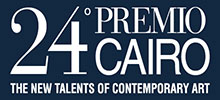7th Premio Cairo
A tenacious attachment to the image despite the great variety of languages. A strong emotional attachment to the subject. A conscious, at times ironic and disenchanted confrontation with tradition. An exercised gaze on the masters of every era. And an aptitude for experimental research, with the occasional foray into the conceptual.
For the seventh Cairo Prize twenty artists return to challenge each other on the terrain of figuration, in all its declinations. With a return to the origins of the prize, the survey of the contemporary languages of painting, photography and sculpture was carried out by the editorial staff of Arte. A faithful mirror of the work in progress from one end of the Peninsula to the other, the exhibition offers precious and convincing testimony of the artists' relationship with reality, through forty works ranging from portraits to still life to landscapes, with a wealth of techniques ranging from the most recent to ancient ones, bent to new requirements.
Selected artists
The 20 selected artists: Alessandra Ariatti, Davide Bramante, Manuele Cerutti, Gerhard Demetz, Tessa Manon Den Uyl, Till Freiwald, Marina Giannobi, Chris Gilmour, Francesco Lauretta, Anna Madia, Andrea Mastrovito, Daniela Perego, Giacomo Piussi, Luigi Presicce, Giuseppe Rado, Luisa Raffaelli, Roberta Savelli, Alessandra Spranzi, Fabio Viale, Massimiliano Zaffino
The Jury
The Jury ios composed by: Fabio Cavallucci (direttore della Galleria Civica di Trento), Daniela Clerici (direttore di Arte), Massimiliano Gioni, Gianfranco Maraniello (direttore di MAMbo Museo d'Arte Moderna di Bologna), Marco Pierini (direttore del Centro d'Arte Contemporanea Santa Maria della Scala di Siena), Patrizia Sandretto Re Rebaudengo (presidente Fondazione Sandretto di Torino) e Stefano Zecchi (scrittore e professore di estetica).
The winner
Chris Gilmour (Stockport, 1973), with his reproduction of an Aperisciò, a cardboard box full of memories and feelings, which surpasses Arte Povera with a love of detail.
Cardboard and glue, actual size.
Award-winning work
Chris Gilmour has always been engaged in the investigation of popular culture through the object. The exclusive material is packing cardboard, practical, cheap, light. And evocative, because it carries with it the idea of container, turning the motorcycles, pianos or cars that come out of his hands into boxes full of memories and feelings. The models are the product of 1950s design, with a predilection for Italian design: the Lambretta, the Ape, the Cinquecento, and Olivetti's glorious Lettera 22. For the design, which is very demanding and can take years, when he does not have the original drawings he has to disassemble the object to know all its secrets. Only then will the cardboard copy be identical to the original in size and down to the smallest bolt. The brittleness and perishability of the material contrasts with the solidity of the model, as in Auto cab, a reproduction of a bee-rickshaw popular in India
